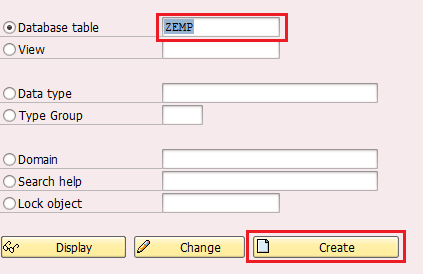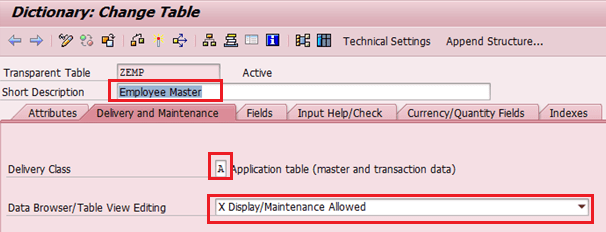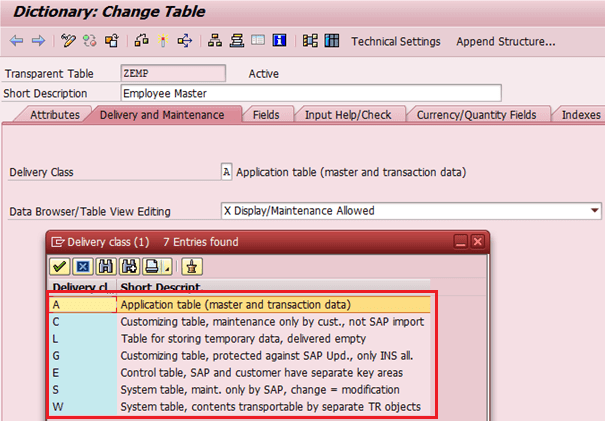Create a Delivery Class in SAP ABAP
SAP ABAP Interview Questions – Real Time
What is Delivery Class in SAP ABAP
When we create a Database table in SAP, the Delivery class needs to be defined. It is a mandatory process.
The Database Delivery Class of SAP Data Dictionary controls the transportation of data to the SAP table.
How to Create Delivery Class in SAP ABAP
Best Laptop for SAP Professionals & Programmers
Step by step explained to Create Delivery Class in SAP ABAP
Step 1: Got SE11 Transaction Code and Type the Database table name.

Step 2: Go to the “Delivery and Maintenance” Tab.

Step 3: Select Delivery Class as per your requirement and save the changes.

What is the use of Delivery Class in SAP ABAP?
It is used when you do the installations, upgrades, Client Copies, and in Transports between Customer Systems.
Delivery Class is defined while creating a new database table in Data Dictionary. Once we enter the new table name, we are redirected to the Tab “Delivery and Maintenance” to define the Delivery Class.
There are many types of Delivery classes in SAP ABAP and each and every class has its important role.
Example:
1) Delivery Class C, G, E, and S: – The data records of the table are copied to the target client.
2) Delivery Classes E, S, and W: – Data is imported. But the system overwrites the existing data records with the same key.
3) Delivery Class G: – The system inserts non-existent data records, but does not overwrite any existing data records in the system.
How many types of Delivery Class in SAP ABAP Data Dictionary?
There are a total of 7 Delivery Classes in SAP ABAP as mentioned below.
It is explained in brief as mentioned below.
Delivery Class A
A: – Application Table: This is for Master Data and Transaction Data. The data is written by Application Programs.
This application table is delivered as an empty table.
The data in client-specific tables are copied only if the appropriate parameter is set in client copies. Any cross-client data is not copied.
In installations, updates, and language imports, the data is only imported in client-specific tables into the system with the client ID “000”, It will overwrite any existing data. Any cross-client data is not imported.
In transports between customer systems. Only the data in the specified target client is respected in client-specific tables.
Delivery Class C
C:- Customer Table:- This is for data entered only by the customer.
Client-specific customer tables can be delivered with patterns for real data.
In client copies, the data of client-specific tables are copied. Any cross-client data will be not copied.
In installations, updates, and language imports, the data in client-specific tables is only imported into the
system client with the client ID “000”, overwriting any existing data. Any cross-client data is not imported.
In transport between customer systems, all data is transported. In client-specific tables, only the data in
the specified target client is respected.
Delivery Class L
L: – Repository Table: Table used as a repository for temporary data. SAP delivers tables in the delivery
class L as empty tables.
These tables are delivered as empty tables.
No data is copied into client copies.
No data is imported in installations, updates, and language imports.
No data is transported in transports between customer systems.
Data entered using extended table maintenance (transaction code SM30) cannot
be transported here.
Global temporary tables always have the delivery class L.
Delivery class G
G:- Customer Table: Where SAP can add data but not modify or delete it. A customer table in the
delivery class G must be assigned a customer namespace in the database table TRESC using the program
RDDKOR54.
Customer tables can be delivered with patterns for real data.
In client copies, the data of client-specific tables are copied. Any cross-client data is not copied.
The data in client-specific tables are imported as follows in installations, updates, and language imports: In
system clients with the client ID “000”, all data is imported, and existing data is overwritten. In other
clients, only new data is imported and no existing data is overwritten. Any cross-client data is inserted
without overwriting existing data.
In transport between customer systems, all data is transported. In client-specific tables, only the data in the
the specified target client is respected.
Any data entered using extended table maintenance (transaction code SM30) is checked here for any
violations of the namespace assigned in the database table TRESC.
Delivery class E
E: – Entries: System table in which customers can make entries. A system table in the delivery class E
must be assigned a customer namespace in the database table TRESC using the program RDDKOR54.
These system tables are delivered with prefilled entries.
In client copies, the data of client-specific tables are copied. Any cross-client data is not copied.
In installations, updates, and language imports, all data is imported and existing data is overwritten.
In transport between customer systems, all data is transported. In client-specific tables, only the data in
the specified target client is respected.
Any data entered using extended table maintenance (transaction code SM30) is checked here for any
violations of the namespace assigned in the database table TRESC.
Delivery Class S
S: – System Table: It is delivered by SAP with predefined data as part of the system, such as
ABAPDOCU_TREE contains the read-only tree of the ABAP keyword documentation.
When transported, the data is handled like repository objects, which means that they have an original
system and any changes in other systems are modifications or repairs.
These system tables are delivered with prefilled entries.
In client copies, the data of client-specific tables are copied. Any cross-client data is not copied.
In installations, updates, and language imports, all data is imported and existing data is overwritten.
In transport between customer systems, all data is transported. In client-specific tables, only the data in
the specified target client is respected.
Delivery Class W
W:– System Table: This is for system administration data, such as TFDIR as a directory of all function
modules.
A system table in the delivery class W is usually delivered with prefilled entries by SAP and can be
affected by customer modifications.
The content is transported using the transport objects assigned to the objects in question, such as R3TR
FUNC for function modules.
These system tables are delivered with prefilled entries.
No data is copied into client copies.
In installations, updates, and language imports, all data is imported and existing data is overwritten.
In transport between customer systems, all data is transported. In client-specific tables, only the data in
the specified target client is respected.
Data entered using extended table maintenance (transaction code SM30) cannot be transported here.
SAP MM – Material Management – Best Exercises